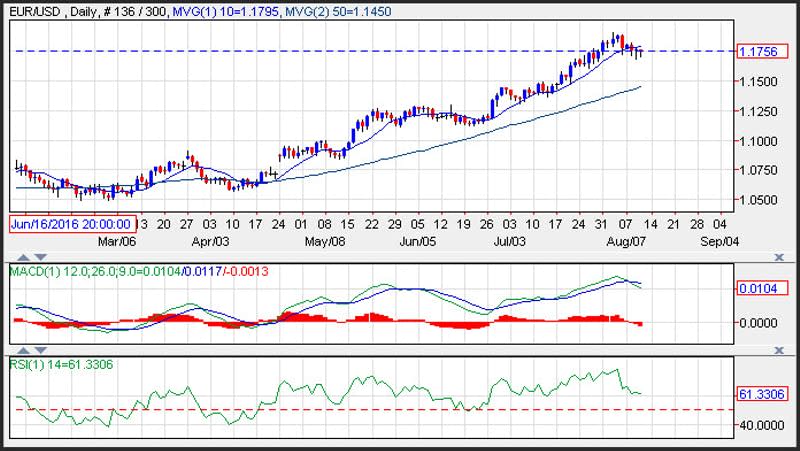EUR/USD Daily Technical Analysis for August 11, 2017
The EUR/USD initially tested lower levels, as French Industrial Production dropped more than expected, and the ECB is expected to hold off on announcing any changes to quantitative easing until September. The currency pair bounced following softer than expected wholesale inflation numbers that were reported by the U.S. Department of Labor. In addition, higher than expected jobless claims were also reported on Thursday.
Technicals
The EUR/USD formed another doji day, as indecision continued to overwhelm traders. The exchange rate also generated an inside day where the low was higher than the prior days lows and the high was lower than the prior days low. Support on the currency pair is seen the 50-day moving average at 1.1450. Resistance is seen near the 10-day moving average at 1.1795. Momentum has turned negative as the MACD (moving average convergence divergence) index recently generated a crossover sell signal. The MACD histogram is printing in the red with a downward sloping trajectory which points to a lower exchange rate.

French Industrial Production Dropped in June
French industrial production dropped 1.1% month over month in June, more than anticipated, although a correction from the 1.9% month over month rise in May was expected. The annual rate fell back to 2.6% year over year from 3.1% year over year, but the correction in June still leaves French production up 1.2% quarter over quarter in Q2 so the data don’t suggest a downward revision to the 0.5% quarter over quarter GDP growth rate reported with the preliminary number.
ECB to announce QE follow up in September
The ECB is expected to announce its follow up to quantitative easing in September accord to the latest Reuters poll. The majority of economists expect the central bank to make an announcement about the future of QE in September 15. Most of the remaining predict an announcement early in 2018, although the latter seems unlikely considering that the current program runs out at the end of the year and the ECB promised to clarify the future of the program beforehand. At the last ECB meeting, it appeared that policy makers favored October as the appropriate time to make a decision on the future of QE, which squares with Draghi’s hints that a decision would come in autumn.
Jobless Claims Rose More than Expected
The 3k U.S. initial claims rise to 244k in the first week of August reversed a 5k drop to 240k to leave a fairly neutral start for the month, as claims have trended sideways since June with little in the way of auto retooling distortions. Claims are entering August near prior averages of 242k in July, 243k in June, 241k in May, and 243k in April. Next week’s BLS survey week figure looks poised to lie near recent BLS survey weak readings of 234k in July, 242k in June, 233k in May, and 243k in April. Our 190k August nonfarm payroll estimate lies below the 209k July rise and 194k Q2 average, but above the 184k average in 2017 and the 187k average in 2016. Payrolls face ongoing upside risk from still-firm consumer, producer, and small business confidence despite Q2 drop-backs, and we’ve seen a solid 217k average ADP rise in 2017 despite the lean 178k July increase. The tightening path in claims stalled through the auto retooling period, however, and vehicle sales and assemblies have remained weak since a big drop in Q1.
Wholesale Inflation Dipped in July
U.S. PPI dipped 0.1% in July on both the headline and core rates. Both are misses. There were no revisions to June’s 0.1% gains. Compared to last July, headline prices slowed to a 1.9% year over year pace from 2.0% year over year. The core rate slipped to 1.8% year over year from 1.9% year over year. Goods prices fell 0.1% after the prior 0.1% gain, with food prices flat from 0.6% previously, while energy declined 0.3% from June’s -0.5%. Services prices slid 0.2% after the prior 0.2% gain. The lack of price pressures in the pipeline suggests CPI will remain tame near term and that should keep the FOMC sidelined, in terms of rate hikes, for now.
The Fed Evans Sees QE Reduction in September
Chicago Fed dove Evans sees balance sheet reduction in September as quite a reasonable juncture to start, while a December rate hike is possible, though dependent on inflation. He argues that the Fed “should be very careful” in assessing future hikes, since he wants more evidence that inflation is heading to 2% sooner than later. Evans sees current policy as accommodative, while the economy is doing well and likely to average 2.25-2.50% growth the next few years, which is how long it will take to unwind the balance sheet. He believes there’s reasonable chance inflation could reach 2% in the next few years and he doesn’t see major risks of financial instability, at least certainly not due to Fed policy.
This article was originally posted on FX Empire
